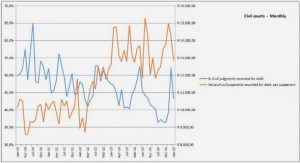Get Complete Project Material File(s) Now! »
Leptonic emission processes
Leptonic models are an elegant way to represent the general blazar SED as they use only one population of particles, the electrons, which are light hence easy to accelerate and interact only in two relevant ways. Furthermore, each of these interactions is fully responsible for one of the bumps. The global neutral charge of the jet is guaranteed by a population of low energy (« cold ») nuclei. It should be noted that positrons are also expected to be produced near the black hole through photon-photon annihilation into electron-positron pairs [27]. Positrons will act in the same way as electrons as they share the same mass and absolute electric charge. Charged particles accelerated in a magnetic field will radiate photons. This process, called synchrotron radiation, is a well known phenomenon that appears naturally when considering the interaction vertex of the electron in the magnetic field and applying laws of conservation. Indeed the interaction is the following : v +e− ! r +e−.
Geometry and environment effects
It was quite evident when developing the possible interactions possible in the jet that the output would be dependent on the properties of the emission region, of the jet and of its environment. Some examples of the possibilities will be highlighted.
Number of emission regions
Not all the jet participates to the observed emission at a given time but it is possible to have multiple regions of the jet active simultaneously. In such a case, the full jet SED will be the superposition of the individual SED. This could lead to wider bumps due to the superposition of shifted SED; uncorrelated low and high energy bumps if one region dominates at low energy and another at high energy; uncorrelated variability depending on the wavelength;
Environment
The local environment of the jet will affect both emission from the jet and absorption of said emission with interactions such as :
• Inverse Compton on an external photon field : The inverse Compton effect detailed in section 1.2.1.1 can occur either on the synchrotron photon from the jet itself, in this case
we speak of synchrotron self-Compton (SSC), or from photons coming from outside the jet. External photon fields can for example originate from the accretion disk, the dusty torus or the BLR. It is important to consider the Lorentz transformation from the AGN rest frame to the jet emission region rest frame. Indeed, the photon energy and direction distribution relevant to the inverse Compton is the one in the jet rest frame. From this it can be concluded that the external photon field contribution to the inverse Compton will be strongly dependent on the emission region distance from the SMBH. Indeed, in order for the target photon field to be dense enough the emission region needs to be close to their source [41].
• Pair production on BLR photons : If the emission region of very high energy gamma-rays is located closer to the central black hole than the BLR, this gamma-rays will encounter a dense low energy photon field from the BLR. When this happens, pairs of e+/e− will be produced by interaction of gamma-rays with BLR photons. This process can significantly reduce the flux at the highest energies.
• Jet cloud collisions [42]: A gas cloud can occasionally cross the jet. When this happens, the jet may be temporarily deflected or slowed. Alternatively, if the jet is powerful enough, the cloud can be disrupted and feed the jet [43].
Extensive air showers
Highly energetic particles tend to interact inelastically. A high energy particle entering a medium is consequently likely to split into secondary particles each carrying a fraction of the initial particle energy while potentially converting part of this energy into mass. If the medium is dense enough and the energies of the secondary particles are still important they are likely to repeat this process creating once again new particles. The repetition of this process in the Earth atmosphere started by gamma-rays and other high energy particles creates millions of particles. Due to the conservation of momentum, each interaction has its product moving away from one another. As a consequence the particles will cover a transverse area increasing with each interaction. This expending blob of millions1 of particles falling from the sky is what is called an extensive air shower. EAS can be separated into two categories : electromagnetic and hadronic.
Electromagnetic showers
Electromagnetic air showers are started either by a charged lepton or a photon. The likelihood of the interaction producing something else than new photons, electrons and positrons is so low in the energy range we are interested in, that it can be considered to be zero in application. Hence, the shower will only develop through electromagnetic interactions. The shower will evolve using two mechanisms :
• pair production : A gamma-ray photon converts to a pair of electron e− and positron e+ when interacting with a virtual photon v from the medium charged particles. + v !e−+e+ (2.2).
• bremsstrahlung : an electron or positron is deflected in the medium and emit a photon. e±+ v !e±+.
Table of contents :
1 Blazars
1.1 Active Galactic Nuclei
1.1.1 General properties and classification
1.1.2 Blazar observational properties
1.2 Relativistic jet emission
1.2.1 Particle composition issue
1.2.2 Geometry and environment effects
2 Very high energy astronomy with imaging atmospheric Cherenkov telescopes
2.1 Very high energy messengers
2.1.1 Cosmic rays
2.1.2 Neutrinos
2.1.3 Gamma-rays
2.2 Extensive air showers
2.2.1 Electromagnetic showers
2.2.2 Hadronic showers
2.2.3 Cherenkov light
2.3 H.E.S.S.: The High Energy Stereoscopic System
2.3.1 Technical properties
2.3.2 Data acquisition
2.3.3 Analysis
2.4 CTA : The Cherenkov Telescope Array
3 Improvement to the analysis software for time dependent signal analysis
3.1 Paris Analysis software : an overview
3.2 Adaptive light curve binning algorithm
3.2.1 Concept
3.2.2 Implementation
3.2.3 Bayesian significance computation
3.3 Bad time interval filtering
3.3.1 Problematic
3.3.2 Event filtering implementation
3.3.3 Example : Clouds during Crab Nebula observations
4 Flare observations and analysis
4.1 The H.E.S.S. Target of Opportunities AGN program
4.2 Flare analysis
4.3 3C 279 flares in 2017 and 2018
4.3.1 High and Very High Energy Observations
4.3.2 Contemporaneous multi-wavelength observations
4.3.3 Multi-wavelength correlation study
4.3.4 Discussion on the VHE detections
4.3.5 Conclusion
4.4 PKS 2022-077 flares in 2016 and 2017
4.4.1 High and Very High Energy Observations
4.4.2 Multi-Wavelength campaign
4.4.3 Study of the high energy cut-off
4.4.4 Conclusion
4.5 The extragalactic Round Up
5 Characterisation of AGN flares
5.1 Goals
5.2 Procedure
5.3 Tools for non uniform time binning
5.3.1 Normalised excess variance
5.3.2 Flux doubling time
6 Lepto-hadronic model : expected neutrinos from TXS 0506+056
6.1 The model
6.2 IceCube-170922A association to TXS 0506+056
6.2.1 The data
6.2.2 The simulation
6.2.3 Proton synchrotron solutions
6.2.4 Mixed lepto-hadronic solutions
6.3 Conclusion
Conclusion
A Background integration
Bibliographie






